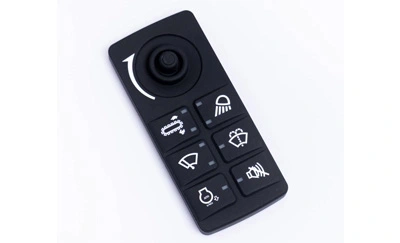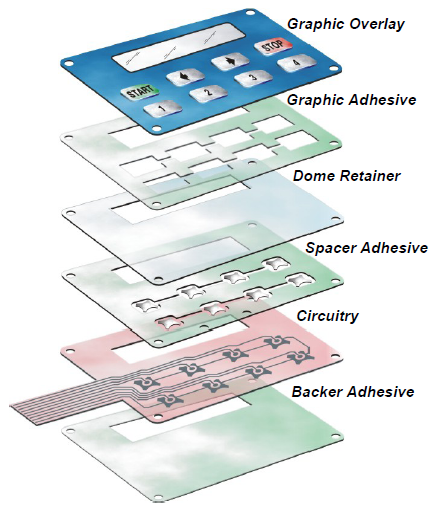All Regarding Membrane Change: A Comprehensive Guide for Beginners
Membrane layer switches are important parts in modern-day electronics, offering an one-of-a-kind user interface for user interaction - membrane switch. Their split building and construction, consisting of overlays and conductive traces, gives capability and longevity. Unlike typical mechanical buttons, membrane buttons offer a smooth design and personalized alternatives. Comprehending their crucial features and advantages can change item style. Nonetheless, the details of their application and design considerations call for additional exploration
What Is a Membrane layer Change?
A membrane button is a type of electric button that includes a versatile membrane layered over a published motherboard. This design permits a portable and smooth user interface, often made use of in various digital gadgets. Membrane switches are generally discovered in consumer devices, clinical devices, and commercial equipment as a result of their resilience and resistance to ecological factors.The building commonly consists of numerous layers, such as visuals overlays and sticky backing, which give tactile feedback and safeguard the wiring below. The procedure of a membrane layer button is launched when pressure is related to the surface, finishing an electrical circuit.These switches are valued for their convenience, allowing custom-made layouts and printed graphics that accommodate specific interface. Their inconspicuous nature minimizes area needs, making them perfect for applications where conventional buttons might not fit. Overall, membrane switches provide a practical and visual service for modern-day digital tools.
Secret Components of Membrane Layer Switches Over
Membrane layer switches consist of several key components that add to their performance and performance. The top layer, called the overlay, supplies the interface and is commonly published with graphics or symbols. Under the overlay lies a spacer layer, which separates the conductive elements and protects against unintentional activation. The following vital part is the graphic layer, which improves appearances and assures the longevity of the design.Conductive traces, typically made from materials like silver or carbon, are published on the circuit layer. When pressure is applied to the overlay, these traces enter contact, finishing the circuit. Furthermore, a support layer provides architectural support and can be made from materials such as polyester or polycarbonate. Together, these elements produce a dependable, straightforward user interface appropriate for various applications, from home home appliances to industrial devices. Recognizing these components is important for anybody thinking about membrane switch innovation.
How Membrane Switches Over Job
Recognizing how membrane layer switches feature is crucial for appreciating their prevalent usage in various devices. A membrane layer switch operates through a collection of layers, including a graphic overlay, spacer, and a circuit layer. When stress is put on the overlay, it presses the spacer layer, permitting the circuit layer to make contact and finish an electrical circuit. This activity sends a signal to the tool, triggering a response, such as activating a light or triggering a function.Membrane changes can be made with numerous functions, including responsive feedback, backlighting, and customized graphics, improving user interaction. Their construction enables a closed layout, protecting the interior components from dirt, wetness, and impurities. This sturdiness makes them ideal for varied applications, from customer electronic devices to commercial tools. Overall, the simplicity and effectiveness of membrane layer changes add to their appeal in contemporary technology.
Advantages of Membrane Switches Over Over Mechanical Switches
While mechanical switches have long been a staple in many tools, membrane layer switches deal distinctive benefits that make them significantly appealing. One significant benefit is their slim profile, permitting even more small designs and greater adaptability in item advancement. In addition, membrane layer switches feature an uniform surface area, which boosts visual allure and simplifies cleaning, making them suitable for atmospheres where hygiene is critical.Another benefit is their resistance to dirt and moisture. Unlike mechanical switches, which can be jeopardized by environmental variables, membrane layer switches offer a closed interface that shields against contaminants - membrane switch. Furthermore, membrane buttons normally have a longer lifespan as a result of fewer relocating parts, resulting in improved sturdiness and reliability.Cost-effectiveness is likewise a notable advantage, as membrane buttons can be created in bulk with reduced manufacturing prices. These elements integrate to position membrane switches as a practical option to traditional mechanical alternatives in various applications
Typical Applications of Membrane Layer Switches Over
Membrane buttons are widely utilized in numerous industries, particularly in consumer electronic devices and commercial control board. In consumer devices, they offer a streamlined, user-friendly interface, while in commercial settings, they enhance longevity and functionality. Comprehending these applications useful site highlights the flexibility and functionality of membrane layer buttons in modern technology.
Customer Electronic Devices Devices
As consumer electronic devices continue to advance, membrane switches have ended up being a popular choice for a variety of gadgets because of their convenience and sleek style. These switches are typically discovered in mobile phones, tablets, and remote controls, where space is limited and appearances issue. Their low profile and adjustable styles enable suppliers to develop straightforward user interfaces that boost the total user experience. Additionally, membrane click over here layer buttons are usually used in appliances such as microwaves and coffee makers, providing intuitive control alternatives while standing up to dampness and dust. The toughness and dependability of membrane switches make them suitable for day-to-day customer products, ensuring longevity and consistent efficiency. Generally, their combination in consumer electronics mirrors a mix of functionality and modern-day style.
Industrial Control Panels
The applications of membrane layer changes expand past consumer electronic devices, locating considerable use in commercial control panels. These buttons are preferred for their toughness and resistance to severe environments, making them suitable for producing and process control setups. They provide a reliable interface for drivers to manage machinery, screen processes, and adjust setups. Membrane buttons can be customized to match certain operational demands, incorporating attributes like backlighting and tactile feedback, boosting individual experience. Their low-profile layout allows for assimilation into different tools, while their ability to hold up against spills, dust, and extreme temperature levels warranties long life. On the whole, membrane buttons contribute to risk-free and effective operation in industrial applications, showing their versatility and efficiency in demanding atmospheres.
Factors To Consider for Creating Membrane Changes
When creating membrane layer switches, selecting the ideal products is vital to assure sturdiness and performance. In addition, recognizing layer setup strategies can greatly affect the switch's efficiency and user experience. These considerations play an essential function in producing reliable and trusted membrane button layouts.
Material Selection Importance
Material choice plays a vital function in the style and performance of membrane switches. The picked products directly impact the switch's longevity, tactile response, and total visual. Secret factors to consider include the substrate, which should provide structural stability while enabling adaptability, and the visuals overlay, which needs to be resistant to wear and ecological elements. Conductive materials should assure reliable electrical performance, while adhesives have to use strong bonding without get redirected here compromising the switch's operation. In addition, compatibility with producing processes and end-user environments is important; materials need to hold up against differing temperatures, humidity degrees, and chemical exposure. Ultimately, ideal product choice not only boosts the membrane button's efficiency however also adds to its durability and customer satisfaction, making it a crucial facet of the layout process.

Layer Setup Techniques

Frequently Asked Inquiries
How Much Time Do Membrane Layer Switches Over Generally Last?
Membrane switches usually have a life-span of 1 to 5 million cycles, depending on usage and ecological conditions. Aspects such as style top quality and operating regularity considerably influence their longevity and overall efficiency long life.

Can Membrane Layer Changes Be Personalized for Specific Styles?
Membrane layer switches can without a doubt be personalized to accommodate certain designs, permitting varied forms, colors, and performances. This convenience makes it possible for producers to customize these buttons to satisfy distinct aesthetic and operational needs efficiently.
What Materials Are Utilized in Membrane Layer Switch Building?
Membrane layer buttons are usually built utilizing materials such as polyester, polycarbonate, and sticky layers. These products supply toughness, resistance, and flexibility to environmental variables, making certain the switches work efficiently in various applications and problems.
Are Membrane Changes Water-proof or Immune to Dampness?
Membrane layer switches can be made to be moisture-resistant, using specialized coverings and products. Their water resistant capabilities depend on construction high quality and specific applications, making it essential to analyze requirements for excellent efficiency in different environments.
Exactly How Are Membrane Layer Switches Fixed if Harmed?
Fixing damaged membrane layer changes typically includes changing the affected layer or circuit. Specialists may likewise apply conductive glue or make use of specialized fixing packages, making certain capability is recovered without complete substitute of the whole switch assembly. Unlike conventional mechanical buttons, membrane layer switches provide a sleek design and personalized choices. A membrane layer button is a type of electrical button that is composed of an adaptable membrane layered over a printed circuit board. The operation of a membrane switch is started when stress is applied to the surface area, completing an electrical circuit.These buttons are valued for their convenience, making it possible for custom-made styles and published graphics that provide to certain customer interfaces. While mechanical switches have long been a staple in numerous devices, membrane changes deal distinctive benefits that make them significantly appealing. Membrane layer buttons typically have a longer lifespan due to fewer relocating parts, resulting in improved durability and reliability.Cost-effectiveness is also a noteworthy benefit, as membrane layer buttons can be produced in mass with lower manufacturing costs.